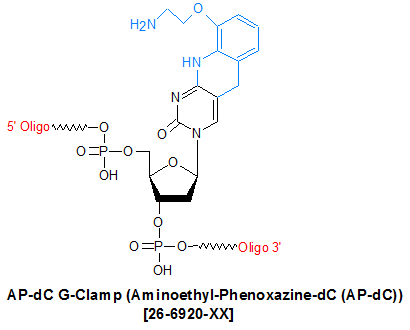
Modification : AP-dC
Catalog Reference Number
Category
Modification Code
5 Prime
3 Prime
Internal
Molecular Weight (mw)
Extinction Coeficient (ec)
Technical Info (pdf)
Absorbance MAX
Emission MAX
Absorbance EC
26-6920
Duplex Stability
[AP-dC]
Y
Y
Y
438.33
7.4
PS26-6920.pdf
-
-
-
| Catalog No | Scale | Price |
| 26-6920-05 | 50 nmol | $497.00 |
| 26-6920-02 | 200 nmol | $497.00 |
| 26-6920-01 | 1 umol | $969.00 |
| 26-6920-03 | 2 umol | $969.00 |
| 26-6920-06 | 5 umol | $4,360.50 |
| 26-6920-10 | 10 umol | $5,167.00 |
| 26-6920-15 | 15 umol | $6,458.00 |
| Discounts are available for AP-dC! |
| Modification* Discount Price Structure |
|
1 site/order
|
List price
|
|
2 sites/order
|
10% discount
|
|
3 sites/order
|
20% discount
|
|
4 sites/order
|
30% discount
|
|
5-9 sites/order
|
50% discount
|
|
10+ sites/order
|
60% discount
|
|
*Exceptions apply
|
Aminoethyl-Phenoxazine-deoxycytosine (AP-dC), sometimes referred to as “G-clamp”, pairs with dG, and when substituted for dC in an oligonucleotide, is able to form both Watson-Crick and Hoogsteen hydrogen bonds with the guanine base. A total of four hydrogen bonds form between AP-dC and dG: the usual three Watson-Crick hydrogen bonds and a Hoogsteen hydrogen bond between the protonated amine of AP-dC’s aminoethyl side-chain and the O6 position of the dG. As a result, an AP-dC:dG base pair significantly increases the stability of the resulting duplex relative to the comparable unmodified form. The increase in stability can be quite dramatic; in one study, a single incorporation of AP-dC in a 10-mer polypyrimidine oligonucleotide raised the Tm of the corresponding duplex by 18 degC over a control duplex containing 5-Me-dC at the same position (1). Moreover, the additional, specific presence of the Hoogsteen hydrogen bond leads to high specificity of AP-dC for dG over the other three bases (1). Thus, AP-dC may be useful in any application in which the ability to discriminate dG in a target is necessary.
Flanagan and co-workers tested AP-dC for its utility in anti-sense oligos. Based on studies of AP-dC-modified anti-sense oligos for sequence-context dependence, activity mismatch, sensitivity, RNAse-H cleavage, and hybridization kinetics, they concluded that AP-dC is a very potent, mis-match sensitive analog for dC, with high potential for improving the potency of anti-sense oligonucleotides (2). In another study, oligos containing one AP-dC at the 3’-end confer resistance to 3’-exonuclease digestion (3).
AP-dC is an excellent choice of modification whenever a large increase in duplex stability and/or specificity for dG in a target is required.
References
1. Lin, K.Y.; Matteucci, M.D. A cytosine analogue capable of clamp-like binding to a guanine in helical nucleic acids.
J. Am. Chem. Soc. (1998),
120: 8531-8532.
2. Flanagan, W.M.; Wolf, J.J.; Olson, P.; Grant, D.; Kuei-Ying, L.; Wagner, R.W.; Matteucci, M.D. A cytosine analog that confers enhanced potency to antisense oligonucleotides.
Proc. Natl. Acad. Sci. (USA) (1999),
96: 3513-3518.
3. Maier, M.A.; Leeds, J.M.; Balow, G.; Springer, R.H.; Bharadwaj, R.; Manoharan, M. Nuclease resistance of oligonucleotides containing the tricyclic cytosine analogues phenoxazine and 9-(2-aminoethoxy)-phenoxazine (“G-clamp”) and origins of their nuclease resistance properties.
Biochem. (2002),
41: 1323-1327.
- AP-dC G-Clamp (Aminoethyl-Phenoxazine-dC (AP-dC))
